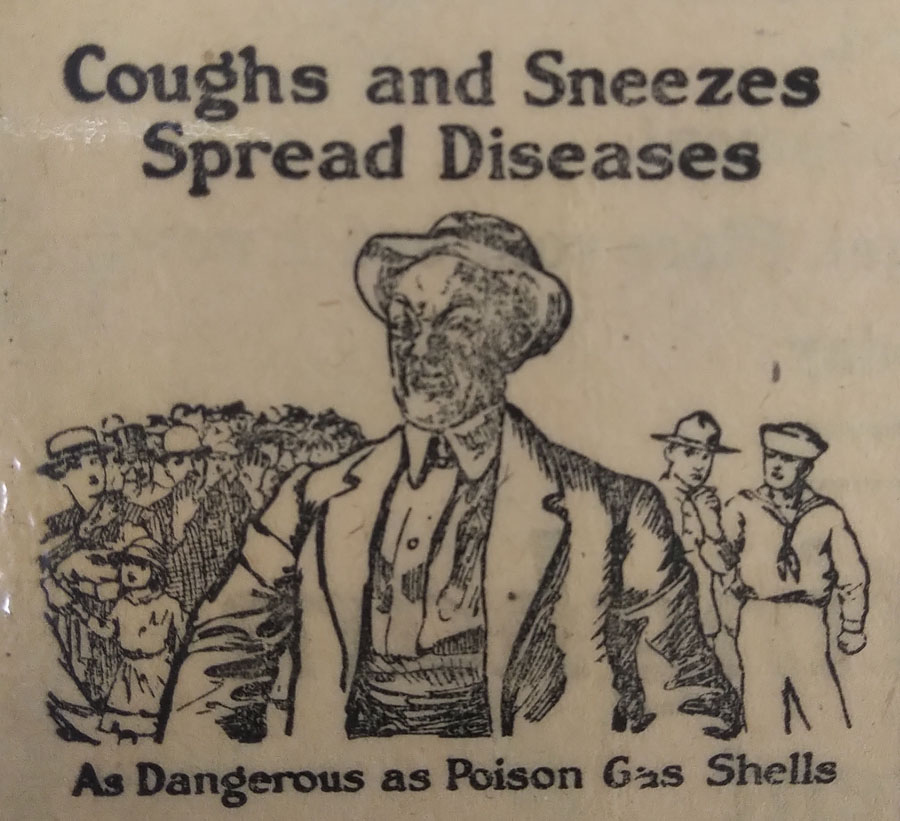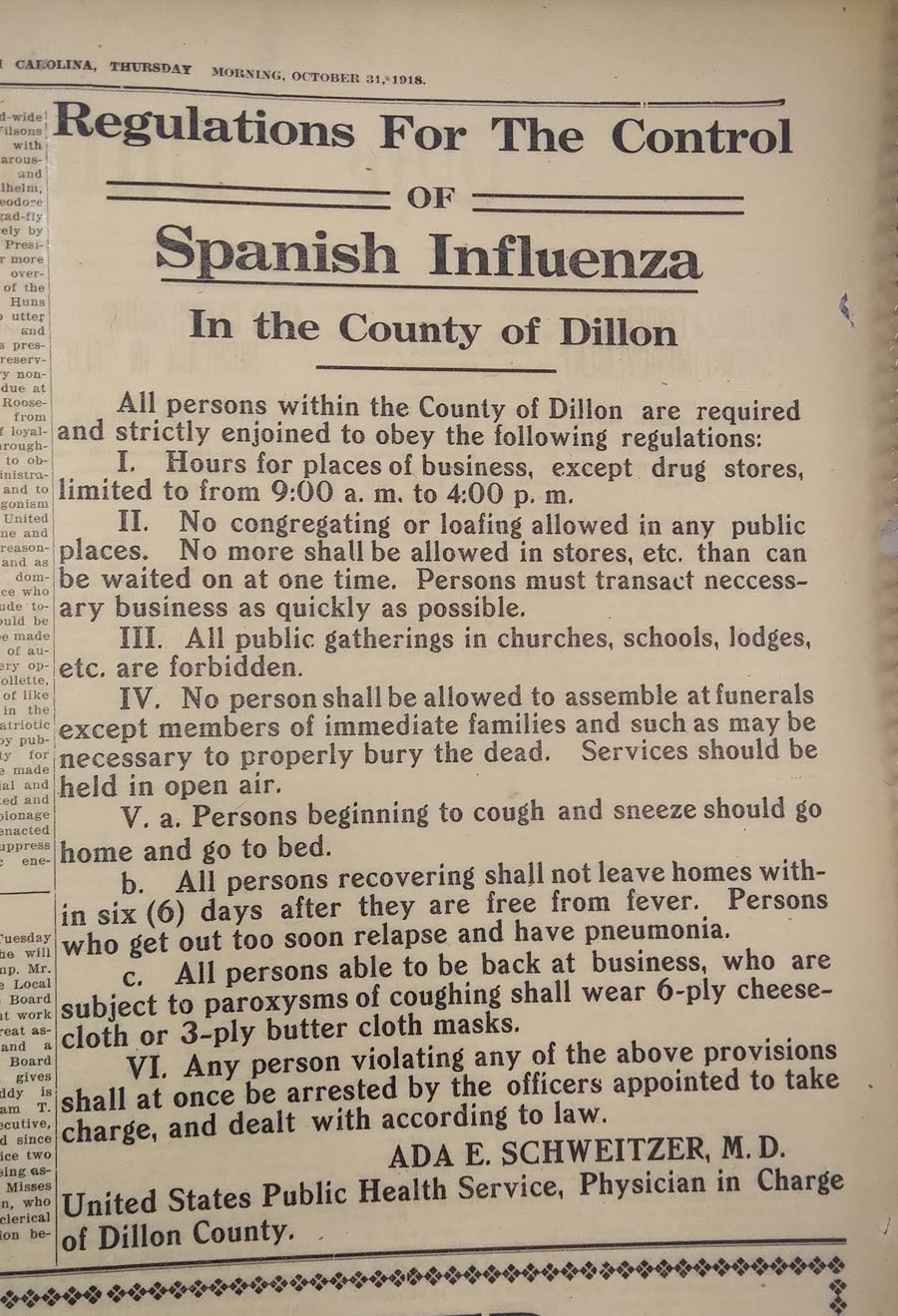By Betsy Finklea
The COVID-19 pandemic is not the first pandemic that Dillon County has suffered through with the rest of the country and world.
In 1918, the Spanish influenza (the flu) took its toll on Dillon County. People were extremely sick and some were dying. Doctors and nurses were stretched to their limits. The flu’s spread forced people to take then unheard of precautions, many similar to what we have to do right now to prevent the spread of COVID-19.

While technology and medical services have vastly improved and advanced over the years, it is interesting to see that many of the same measures have been taken in the current pandemic as were taken more than 100 years ago.
Here is a brief look at the beginning of the pandemic.
On October 17, 1918, The Dillon Herald reported on the severity of the flu in the county and the big toll that was being taken on human life. “The flu situation in Dillon has reached a serious stage. About 600 cases have been reported in a radius of four miles of town. Physicians and nurses are working night and day, but it is only a matter of time before they will fall out of the ranks. The city authorities are working with the Red Cross in an effort to check the spread of the disease. Relief quarters have been set up in E.L. Moore’s office and extreme cases should be reported by telephone. Volunteer nurses are being assigned to homes, and nourishment is being prepared for families who have no one to wait on them. No loitering is permitted on the streets and extra policemen have been put on to keep the crowds moving.”
Some people in town who had died as a result of the flu in this report were a well-known merchant, N.M. Blanton; Andrew Cook, a farmer who lived near the mill village; Walter Bethea, a man on John Ellen’s place; Tom Huggins, one of the county’s largest and most successful farmers; Mrs. Smith, a widow woman with four small children; and several other deaths, but the names were not known at the time of this report. As time passed, this list continued to grow.
Everyone was urged to cooperate with health authorities in the fight against influenza. A relief committee was appointed by the Red Cross to assist in the fight against influenza. It included Miss Ruth Allen at the Central Relief Station and Ward Chairmen Mrs. L.C. Braddy, Mrs. John C. Bethea, Mrs. C.L. Wheeler, Mrs. John Hargrove, and Mrs. L. Cottingham.; Cotton Mills-Mrs. Branford and Miss Mary Fore; and nurses: Miss Hyatt, Miss McLean, Miss Eula Braddy, Miss Edith Elliott, Miss Ruth Stackhouse, Miss Coppedge, Miss Critz, and Misses Winnie and Lacy Jackson.
By the next paper, October 24, 1918, the situation was worsening. Churches began canceling services, and the mills were running half-time. The situation worsened to the point that health officials were calling on government help to come and address the situation. Help arrived to take charge of the situation.
A temporary hospital was set up for the black population staffed by Dr. Gordon, two trained nurses, and assistants.
By the October 31, 1918 issue of The Herald, the flu situation was showing some improvement, but many regulations were in place. Stores were ordered to close on Saturdays by the Board of Health to keep people from congregating. Weekly guidelines were printed on the front page of the Herald; however, failure to follow the guidelines issued by the United States Public Health Services Physician-In-Charge in Dillon County could result in your arrest.

Some of these regulations included:
“All persons within the County of Dillon are required and strictly enjoined to obey the following regulations:
I. Hours for places of business, except drug stores, limited from 9:00 a.m.-4:00 p.m.
II. No congregating or loafing allowed in any public places. No more shall be allowed in stores, etc. than can be waited on at one time. Persons must transact necessary business as quickly as possible.
III. All public gatherings in churches, schools, lodges, etc. are forbidden.
IV. No person shall be allowed to assemble at funerals except members of immediate families and such as may be necessary to properly bury the dead. Services should be held in open air.
V. a. Persons beginning to cough and sneeze should go home and go to bed.
b. All persons recovering shall not leave homes within six (6) days after they are free from fever. Persons who get out too soon relapse and have pneumonia.
c. All persons able to be back at business, who are subject to paroxysms of coughing shall wear 6-ply cheesecloth or 3-ply butter cloth masks.
VI. Any person violating any of the above provisions shall at once be arrested by the officers appointed to take charge, and dealt with according to law.
ADA E. SCHWEITZER, M.D.
United States Public Health Service, Physician in Charge of Dillon County”
There are many more issues of The Dillon Herald between 1918-1920 that note deaths and other items related to the flu pandemic. The Spanish Flu Pandemic lasted through 1920. Lives were lost and changed forever in Dillon County, the nation, and the world.


